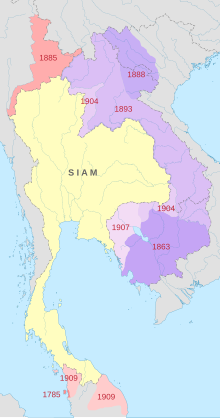Syburi
| Saiburi (Syburi) ไทรบุรี | |||||||||
|---|---|---|---|---|---|---|---|---|---|
| Province of Thailand | |||||||||
| 1943–1945 | |||||||||
 Map of Thailand's territorial losses, used as a justification for the annexation | |||||||||
| Capital | Alor Setar | ||||||||
| History | |||||||||
| 18 October | |||||||||
• Thailand returns annexed territories to United Kingdom | 2 September | ||||||||
| |||||||||
| Today part of | Malaysia | ||||||||
Syburi (Thai: ไทรบุรี;[2] RTGS: Sai Buri, meaning "City of the Banyan") is the name for the Malay state of Kedah returned to Thailand when the Japanese occupied British Malaya during World War II.
History
[edit]
General Plaek Phibunsongkhram signed a secret agreement with the Japanese Empire on 14 December 1941 and committed the Thai armed forces to participate in the planned Malayan Campaign and Burma Campaign. An alliance between Thailand and Japan was formally signed on 21 December 1941. On 25 January 1942, the Thai government, believing the Allies beaten, declared war on the United States and the United Kingdom. As a reward for entering into a military alliance with the Japanese, the latter agreed to return to Thailand the four Malayan provinces ceded to the British in 1909, Kedah, Perlis, Kelantan, and Terengganu, as well as parts of Shan State in British Burma.[4][5] In July 1943, Japanese Prime Minister Hideki Tojo announced that Kedah (along with Perlis, Kelantan and Terengganu) were to be returned to Thailand as part of the military alliance signed between Thailand and Japan on 21 December 1941.
From 18 October 1943 until the surrender of the Japanese at the end of the war, Kelantan, Terengganu, Kedah and Perlis were under Thai administration. On 2 September 1945, Kedah and the three other states were returned to the British.
People from Syburi have interacted with people from Phuket and Nakhon Si Thammarat and the result has been a number of marriages between Buddhists and Muslims.[6]
Administration
[edit]Administrative services were carried out by Thai civil servants who were under military supervision. The Japanese authorities retained a great degree of control.[7]
Japanese Governors
[edit]- 1941 – Mar 1942 Ojama
- Mar 1942 – Oct 1943 Sukegawa Seiji (Seichi)
Thai Military Commissioner
[edit]- Oct 1943 – 1945? Pramote Chong Charoen
Thai General-Commissioners
[edit]Administering Kedah, Kelantan and Terengganu:[8]
- 20 Aug 1943 – Oct 1943 Kamol Saraphaisariddhikan Chotikasathion
- Oct 1943 – 1945? Chierlah Kamol Sribhaasairadhikavan Josikasarthien
Documents
[edit] |
See also
[edit]References
[edit]- ^ "THAILAND 1944 OCCUPATION OF MALAYA KEDAH, 'SYBURI' 10C". Retrieved 2 September 2021.
- ^ "ประกาศราชบัณฑิตยสถาน เรื่อง กำหนดชื่อประเทศ ดินแดน เขตการปกครอง และเมืองหลวง (พ.ศ. 2544)" (PDF). ราชกิจจานุเบกษา (in Thai). 118 (ตอนพิเศษ 117ง): 2. 26 November 2001. Archived from the original (PDF) on November 28, 2009.
- ^ Timtsunami8 (2020-08-31), English: An updated version of the map, retrieved 2021-06-21
{{citation}}: CS1 maint: numeric names: authors list (link) - ^ Thailand in Malaya Archived 2014-08-28 at archive.today
- ^ "สงครามมหาเอเซียบูรพา - จากวันวีรไทย ถึง วันประกาศสงคราม". samphan. I See History dot com. September 2009. Archived from the original on 25 February 2021. Retrieved 8 August 2010.
- ^ Gavin W. Jones, Chee Heng Leng, Maznah Mohamad eds. Muslim-Non-Muslim Marriage: Political and Cultural Contestations in Southeast Asia. Institute of Southeast Asian Studies, 2009. p. 197
- ^ Prof. Madya Dr. Mohd. Isa Othman The Second World War and the Japanese Invasion of Kedah
- ^ Malay States

![Coat of arms[1] of Syburi](http://upload.wikimedia.org/wikipedia/commons/thumb/1/11/Coat_of_arms_of_Kedah.svg/85px-Coat_of_arms_of_Kedah.svg.png)